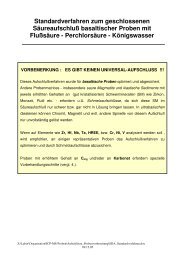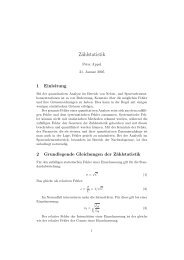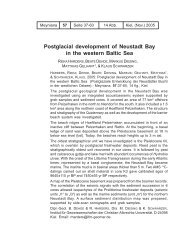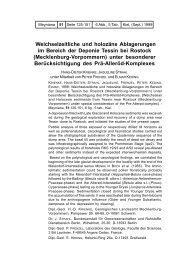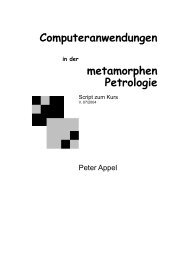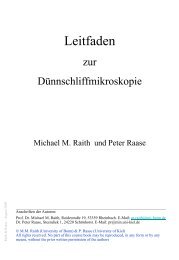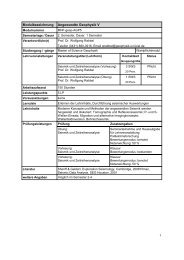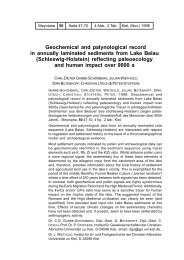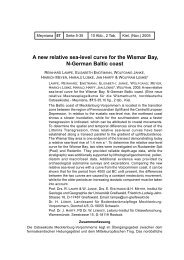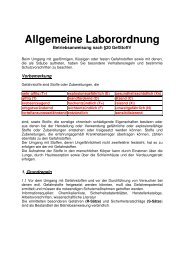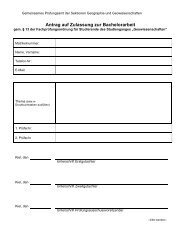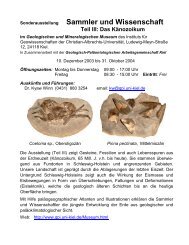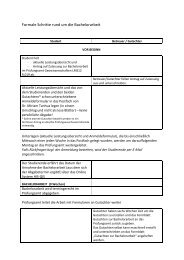Untersuchung zur Stratigraphie und Tektonik im Gebiet Munt ...
Untersuchung zur Stratigraphie und Tektonik im Gebiet Munt ...
Untersuchung zur Stratigraphie und Tektonik im Gebiet Munt ...
Erfolgreiche ePaper selbst erstellen
Machen Sie aus Ihren PDF Publikationen ein blätterbares Flipbook mit unserer einzigartigen Google optimierten e-Paper Software.
<strong>Untersuchung</strong> <strong>zur</strong> <strong>Stratigraphie</strong> <strong>und</strong> <strong>Tektonik</strong> <strong>im</strong> <strong>Gebiet</strong> <strong>Munt</strong><br />
Müsella / Val Burdun, Ober-/ Unterostalpin, Graubünden, Schweiz<br />
Kartierung: 46 Seiten<br />
Kurzfassung:<br />
BEATE WENSKOWSKI<br />
Im Sommer 1999 erfolgte eine Geländeaufnahme unter- <strong>und</strong> oberostalpiner Einheiten <strong>im</strong><br />
<strong>Gebiet</strong> <strong>Munt</strong> Müsella / Val Burdun <strong>im</strong> Maßstab 1:10 000. Die Kartierung der geologischen<br />
Gegebenheiten nach stratigraphischen <strong>und</strong> strukturgeologischen Gesichtspunkten ermöglicht<br />
die Aufstellung eines Models der geologischen Entwicklung dieses <strong>Gebiet</strong>es.<br />
Im Kartiergebiet sind das Kristallin der Müsella-Schuppe, mit einer triassischen sed<strong>im</strong>entären<br />
Auflage, sowie das Languard-Kristallin aufgeschlossen. In der stratigraphischen Abfolge der<br />
sed<strong>im</strong>entären Abdeckung fehlt für die Ostalpienen Alpen typische Verrucano des Perms, sowie<br />
der Jura. Kristallin <strong>und</strong> Sed<strong>im</strong>ente der Müsella-Schuppe weisen eine metamorphe Veränderung<br />
der Grünschieferfazies auf, als Folge der starken tektonischen Überprägung der Einheiten. Aus<br />
südlicher Richtung wurden die unterostalpinen Einheiten der Müsella-Schuppe von der<br />
oberostalpinen Languard-Decke überschoben. Sie wird als ein eigenständiges Stück der<br />
Campo-Decke betrachtet. Des weiteren wurde <strong>im</strong> Liegenden der sed<strong>im</strong>entären Auflage der<br />
Müsella-Schuppe ein in der Literatur bislang nicht beschriebener ca. 200 m 2 großer, kristalliner<br />
Span, die Müsellino-Schuppe, kartiert. Dünnschliffbeobachtungen bestätigen eine Zuordnung<br />
dieses Spans zum Müsella-Kristallin.<br />
Im Gelände sind die Überprägungsmerkmale zweier alpiner deformationsphasen gef<strong>und</strong>en<br />
worden, welche in die Kreide eingegliedert sind. In der Trupchun-Phase (D1) erfolgte eine<br />
Steilstellung der Schichten. Assoziiert treten steilstehende Falten in den inkompetenten<br />
Einheiten der Sed<strong>im</strong>ente, insbesondere des Wettersteinkalkes auf. Des weiteren wurde eine<br />
Verschuppung der kompetenten Formationen beobachtet. Die Ducan-Ela-Phase (D2) besitzt<br />
einen extentionalen Charakter. Sie zeichnet sich <strong>im</strong> gelände durch E-W streichende, liegende<br />
Kollapsfalten mit flachen Faltenachsen aus. Indizien für weiter Deformationsphasen konnten<br />
nicht gef<strong>und</strong>en werden.
Evidence for recycled Jurassic Ocean Crust in the Genesis of Arc<br />
Melts in the Northern Kurile Island Arc<br />
Laborarbeit: 39 Seiten<br />
Abstract:<br />
BEATE WENSKOWSKI<br />
The magmatic evolution in subduction zones is a complex product of fluids and/ or melts of<br />
the subducted oceanic crust and sed<strong>im</strong>ents, as well as mantle processes at different levels. The<br />
Kurile Island Arc, in special, is divided in to two trench-parallel volcanic chains, the volcanic<br />
front and the rear arc. With this systematic difference of volcano locations, it is possible to<br />
investigate the influence of these components by viewing the geochemical coherence. This<br />
study presents a suite of major and trace element data as well as Sr, Nd and Pb isotopic<br />
composition of 21 volcanic rocks of the Kurile Island Arc.<br />
All samples show a relative enrichment of fluid-mobile elements such as Rb, Ba, U, K and Sr<br />
and a relative depletion of fluid-<strong>im</strong>mobile elements such as Nb, Zr, Hf, Ti relative to MORB as<br />
characteristic for subduction zones. Viewing the isotopic ratios, Sr and Pb are mainly derived<br />
from fluids of the subducted ocean crust in the subduction system of the Kurile Arc, while Nd<br />
isotopic composition reflects mantle values. The volcanic front rocks have higher radiogenic<br />
87 Sr/ 86 Sr, 143 Nd/ 144 Nd, 207 Pb/ 204 Pb and 208 Pb/ 204 Pb isotope ratios then those from the rear arc,<br />
reflecting fluid influence of the dehydrating down-going slab, whereby the less radiogenic<br />
143 Nd/ 144 Nd as well as high Th/Nb, Th/Yb and Zr/Nb in the rear arc mirrors a slight sed<strong>im</strong>entmelt<br />
component. The hydrothermally altered, subducted ocean crust can be identified as the<br />
main fluid source in this arc system, although higher ratios of mobile to <strong>im</strong>mobile elements (e.g.<br />
Ba/Th, K/Th, U/Th) in the volcanic front are likely to reflect fluid flux from the subducting slab.<br />
Higher ratios of more to less incompatible, <strong>im</strong>mobile elements (La/Ce, La/Nd, La/Sm and<br />
Nd/Sm) in the rear arc than in the volcanic front, are likely to reflect mantle mechanism, perhaps<br />
at a shallower level.



